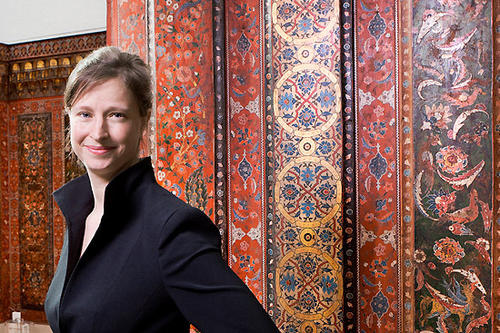Seductive Images
Islamic and Christian art, Compared
Aug 28, 2010
Art historian Vera Beyer heads the Emmy Noether Junior Research Group “Kosmos/Ornatus. Ornament in Persia and France c. 1400 in Comparison.”
Image Credit: Steffen Jänicke
“Thou shalt not make graven images,” says the second commandment of the Hebrew Bible. Behind it lies the fear that the adoration that people are supposed to feel for God alone could be transposed to the deity’s visible or tangible image: an idol.
The question of whether and how to depict the Prophet Mohammed has also been disputed in Islamic law. But reality, in all its many images, has often told a different story. Pictures have been a constant in the cultural development of the human race since its very origins, giving us a way to capture ephemeral events or interpret individual perceptions.
Biblical narratives were illustrated very early on: on Roman sarcophagi, in synagogues, churches, and books, as sculptures, frescoes, and paintings. In the sacral art of Islam, images of people and animals were less prevalent, but there was often no question of full rejection of all images in palaces and other representative buildings.
“Even the most stringent forms of monotheism – those religions that acknowledge only one God – were obviously unable to make a dent in the attractiveness of images. Not the Jewish faith, not the Christian one, not the Islamic one,” says Vera Beyer. The 34-year-old Beyer, who won an award for outstanding new academic talent from the governing mayor of Berlin in 2009, is the head of an Emmy Noether junior research group funded by the German Research Foundation (DFG) at the Department of Art History of Freie Universität Berlin. The researchers have been studying Christian and Islamic art of the late Middle Ages for two years.
During this period, Christianity and Islam shared more than their foundations in the Old Testament; from the Middle East all the way to Spain, Muslims and Christians also maintained close contact, whether as neighbors or in the political or commercial sphere. These relationships are also reflected in the Christian and Islamic traditions of representative art, which developed in this climate of contact and conflict.
“You hear all the time that the difference is that the Christian European style of painting is representational and figurative, and that Islamic art shuns images and is thus ornamental in nature. The contrast is not quite that stark,” says Beyer, who has a firm academic grasp of the commonalities between the two cultures at the same time.
For example, pictures – whether or not they had anything to do with the divine – were used to tell stories in both cultures. One example of this is the story of Joseph and Potiphar’s wife, called Suleika in an Islamic context. The story was depicted and passed along in both text and pictorial form, in Christian and Islamic cultures alike.
In its analysis of the images used, the research group is investigating whether the Persian depiction of figures, which was less plastic on the whole, was due to a lack of skill or technique, or whether, instead, the images were intended to convey a spiritual quality of beauty. “In our view, an image is not deficient just because it doesn’t have any spatial perspective – a criterion for judging quality that has been favored in the Christian European artistic tradition for 500 years. It’s just that more emphasis is placed on spiritual dimensions of beauty,” Beyer says.
Many art objects have traveled through various regions and religions and changed over time. To art historian Beyer, reconstructing the processes of change and the interaction between cultures is more exciting than simply investigating an object’s origins. Images are perfect objects of study in this regard. After all, we can trace the seductive pull of images – second commandment notwithstanding – right down to today’s digital world.
Further Information
Dr. Vera Beyer
Tel.: +49 (0) 30 838-561 91
Fax: +49 (0) 30 838-538 10
e-mail: vera.beyer@fu-berlin.de

